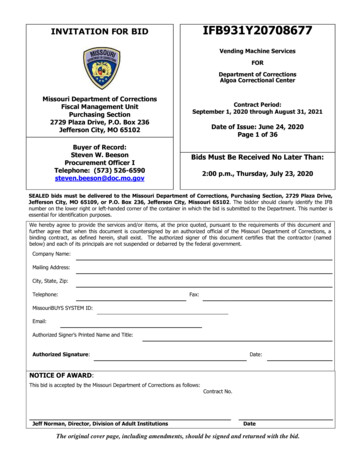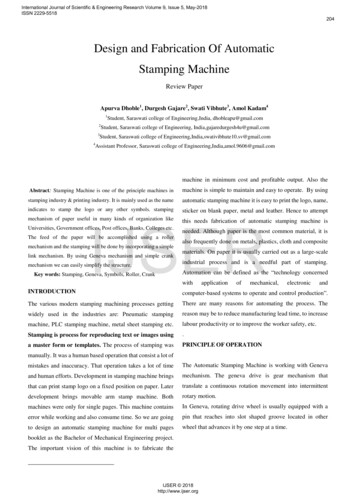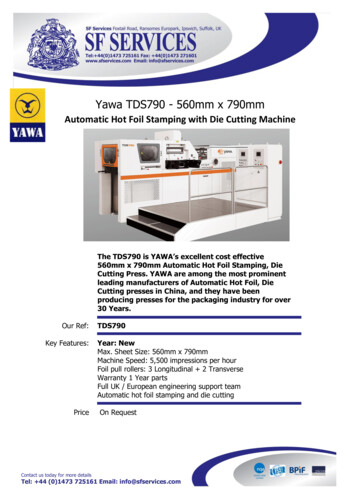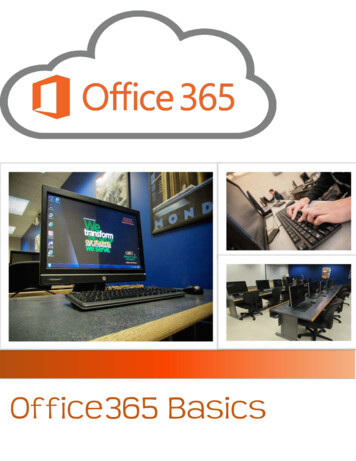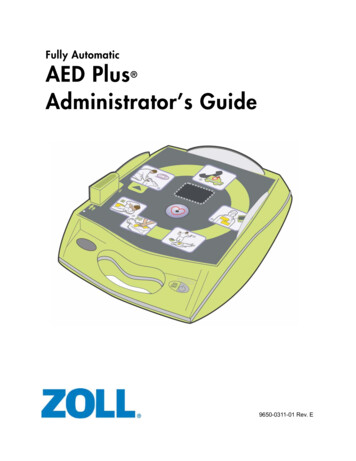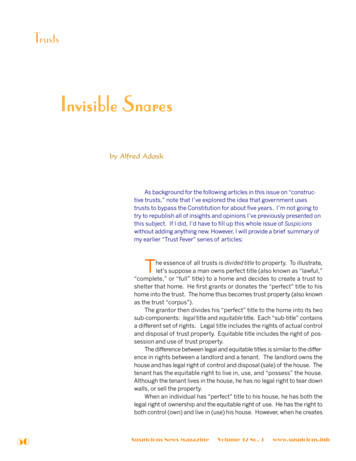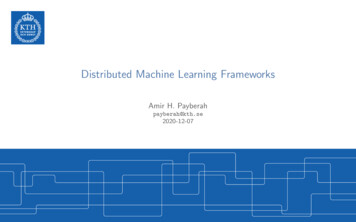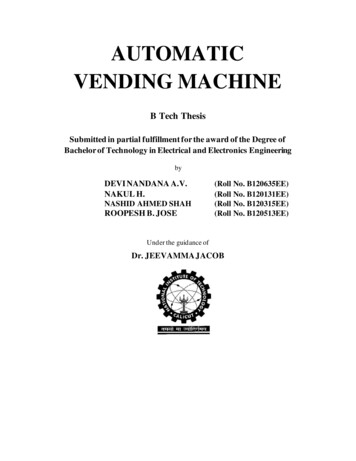
Transcription
AUTOMATICVENDING MACHINEB Tech ThesisSubmitted in partial fulfillment for the award of the Degree ofBachelor of Technology in Electrical and Electronics EngineeringbyDEVI NANDANA A.V.NAKUL H.NASHID AHMED SHAHROOPESH B. JOSE(Roll No. B120635EE)(Roll No. B120131EE)(Roll No. B120315EE)(Roll No. B120513EE)Under the guidance ofDr. JEEVAMMA JACOB
Department of Electrical EngineeringNATIONAL INSTITUTE OF TECHNOLOGY, CALICUTNIT Campus P.O., Calicut - 673601, IndiaMay 2016CERTIFICATEThis is to certify that the report entitled “AUTOMATIC VENDINGMACHINE” is a bona fide record of the major project done by DEVI NANDANAA.V. (Roll No. B120635EE), NAKUL H. (Roll No. B120131EE), NASHIDAHMED SHAH (Roll No. B120315EE) and ROOPESH B. JOSE (Roll No.B120513EE) under my supervision and guidance, in partial fulfillment of therequirements for the award of Degree of Bachelor of Technology in Electrical &Electronic Engineering from National Institute of Technology, Calicut for the year2016.Dr. JEEVAMMA JACOB(Guide)Professor & HeadDept. of Electrical EngineeringPlace: CalicutDate: 12/05/2016
ACKNOWLEDGEMENTWe would like to thank Dr. Jeevamma Jacob for her guidance and constantsupervision as well as for providing the necessary information regarding the projectand also for her support in completing the project.We would also like to express our gratitude towards our faculty for their kindco-operation and encouragement which helped us in the completion of this project.DEVI NANDANA A.V.NAKUL HNASHID AHMED SHAHROOPESH B JOSE
ABSTRACTA vending machine is a machine that dispenses items such as snacks,beverages, alcohol, cigarettes, lottery tickets to customers automatically, after thecustomer inserts currency or credit into the machine.The vending machine prototype that has been developed consists of the followinga) RFID based user recognition systemb) Spring based dispensing mechanism using 2 motors controlled by IR sensors.c) Personal account recharging facility using GSM module.The users can purchase their RFID tags from the machine operator / shopowner after paying an amount which will be credited into the accounts. The accountinformation is stored in the EEPROM of the microcontroller used. The user canregister his/her choice of product using two externally connected switches. Oncethe product is selected and user is identified, the account balance is checked toensure that it will be sufficient to complete the transaction. The motors of thedispensing unit are controlled using an electro-mechanical drive (relay) operatedusing a transistor connected to the microcontroller. Each motor drives a springwhich moves the product stacked between its turns and once a product reaches thebrim, it falls down the dispenser. The falling product intercepts an IR sensor whichgives signal to the microcontroller to stop the rotation after one unit is dispensed.If the balance is inadequate, the user gets an alert on his mobile phone. The accountcan be recharged after paying the concerned amount to the vending machineoperated who maintains a secure code for recharging the accounts using the GSMmodule. The customer can continue hassle free purchase thereafter.
CONTENTSChapter No1TITLEINTRODUCTIONPage no.11.1Introduction11.2Significance11.3Popularity in India21.4Outline of project2REVIEW OF MODELS322.1Introduction32.2Literature review32.3Research gap42.4Objectives52.5Summary53MECHANISM OF VENDING MACHINE63.1Introduction63.2Mechanism63.3Coin sorter63.4Coin sensor73.5Microcontroller73.6Summary74RESULTS AND ANALYSIS84.1Introduction84.2Project research84.3Targeted users84.4Task analysis9
4.55Functions and feature analysis94.5.1Selection94.5.2Screen display104.5.3.4.5.4Coin slotAdditional ERENCESAPPENDIX
CHAPTER 1INTRODUCTION1.1 IntroductionA vending machine is a machine that dispenses items such as snacks,beverages, alcohol, cigarettes and tickets to customers automatically, after thecustomer inserts currency or credit into the machine. The first modern vendingmachines were developed in England in the early 20th century and dispensedpostcards. In this project, the importance of a modern vending machine usingArduino has been undertaken.1.2 SignificanceThe first modern coin-operated vending machines were introduced inLondon, England in the early 1880s, dispensing postcards. The machine wasinvented by Percival Everitt in 1883 and soon became a widespread feature atrailway stations and post offices, dispensing envelopes, postcards, and notepaper.The Sweetmeat Automatic Delivery Company was founded in 1887 in England asthe first company to deal primarily with the installation and maintenance of vendingmachines.The first vending machine in the U.S. was built in 1888 by the ThomasAdams Gum Company, selling gum on New York City train platforms. The idea ofadding games to these machines as a further incentive to buy came in 1897 whenthe Pulver Manufacturing Company added small figures, which would movearound whenever somebody bought some gum from their machines. This ideaspawned a whole new type of mechanical device known as the "trade stimulators".
1.3 Popularity in IndiaVending machines are not very common in India and are usually found onlyin major cities or along some national highways. Seaga India, a 100% subsidiary ofthe Seaga Group of USA, is the pioneer for bringing the concept of vendingmachines to India. Seaga India's machines are being used by the Delhi Metro, theState and Central Government, IT parks, factories, BPO, etc.Vending machines are used to sell snacks, beverages, condoms, publictransit tickets, jewellery and change for currency notes.Several reasons have been attributed to the lack of success of vendingmachines in India. The availability of cheap labour makes operating stores or kioskseconomical; customers lack of technical knowledge and feel uneasy using vendingmachines; a lack of machines that accept a wide variety of payment methods;vandalism, rough use, and poor maintenance of the machines. However, vendingmachines are relatively new in India and analysts believe that usage will rise.1.4 Outline of the reportChapter 2 reviews the existing models.Chapter 3 describes the mechanism of modern vending machines.Chapter 4 analyses the results obtained.Chapter 5 concludes the project.References are included at the end.
CHAPTER 2REVIEW OF MODELS2.1 IntroductionAutomatic vending machines are a common sight in business centers, mallsand airports, etc. where easy dispensation of products without employingmanpower is required. This project aims to make a similar unit, replicating the basicfunctions and modifying others to suit the purview of this project.The conceptualization of the project at various stages relies on existingmodels and literature. The following is a brief discussion on the models reviewedis given on section.2.2 Literature review2.2.1 Design and implementation of coin vending machine using Verilog HDL –Vending machine is implemented using FPGA board. The mechanism usesthree different coins to supply four products. Coins are accepted as inputs in anysequence and when the required amount is deposited the product is dispensed.Change reclamation is also incorporated as a feature if entered amount is greaterthan the price of the product. The customer is entitled to cancel the order at will atany time and the money deposited will be returned. The proposed algorithm isimplemented in Verilog HDL and simulated using Xilinx ISE simulator tool. Thedesign is implemented on Xilinx Spartan-3A FPGA development board. Theprocess of differentiating the coins is a complex and costly one.
2.3 Research gapThe major problem with having a coin operated vending machine is theprocess of differentiating the coins. In our country, there are a lot of coins availablefor the same denomination; this makes the segregating procedure difficult.Furthermore, the sizes of the coins are more or less the same, hence the gravitysorting mechanism cannot be used. The magnetic circuit method which measuresthe current generated by a change in the magnetic field is inefficient as the magneticmaterial content in the Indian coins is more or less the same. Technology is takingover the world and coins won’t last long. Coins get tampered and may not bedifferentiated properly. The only advantage of coin-based vending machine is thathacking is difficult. The technology-based NFC (Near Field Communication) andRFID (Radio Frequency Identification) are prone to hacking.2.4 Objectives Developing a centralized dispensation unit which reduces labour. Developing a user-friendly mechanism to dispense goods which arerequired on a day-to-day basis or demanded by many. Reducing manpower input, wastage of time and energy associated withconventional purchases. Popularizing this alternative in India where vending machines are yet togarner wide appreciation Decomposing the complexity involved and build a prototype satisfying therequirements mentioned above.2.5 SummaryVarious models were reviewed to obtain a plausible method for this project.The next chapter gives a description on the mechanism of vending machine.
CHAPTER 3COMPONENTS3.1 IntroductionThe components required are Arduino Board GSM Module: SIM900A RFID Module/ RFID cards with RS232 interfacing protocol EM-18 reader module (baud rate (9600 for our project)) LCD – 16x2 Power supply 220/9V Relay (Goodsky RWH-SH-1120) External switches Spring coil (10 turns, 8cm) DC motor (12V)3.2 Arduino3.1.1 IntroductionArduino is an open-source prototyping platform based on easy-to-usehardware and software. Arduino boardsare able to read inputs - light on a sensor, afinger on a button, or a Twitter message - and turn it into an output - activating amotor, turning on an LED, publishing something online. You can tell your boardwhat to do by sending a set of instructions to the microcontroller on the board. Todo so you use the Arduino programming language(based onWiring), and theArduino Software (IDE), based on Processing.
Over the years Arduino has been the brain of thousands of projects, fromeveryday objects to complex scientific instruments. A worldwide community ofmakers - students, hobbyists, artists, programmers, and professionals - has gatheredaround this open-source platform, their contributions have added up to an incredibleamount of accessible knowledge that can be of great help to novices and expertsalike.Arduino was born at the Ivrea Interaction Design Institute as an easy toolfor fast prototyping, aimed at students without a background in electronics andprogramming. As soon as it reached a wider community, the Arduino board startedchanging to adapt to new needs and challenges, differentiating its offer from simple8-bit boards to products for IoT applications, wearable, 3D printing, and embeddedenvironments. All Arduino boards are completely open-source, empowering usersto build them independently and eventually adapt them to their particular needs.The software, too, is open-source, and it is growing through the contributions ofusers worldwide.
3.1.2 Arduino boardStarting clockwise from the top center: Analog Reference pin (orange) Digital Ground (light green) Digital Pins 2-13 (green) Digital Pins 0-1/Serial In/Out - TX/RX (dark green) - These pins cannotbe used for digital i/o (digitalRead and digitalWrite) if you are also usingserial communication (e.g., Serial.begin). Reset Button - S1 (dark blue) In-circuit Serial Programmer (blue-green) Analog In Pins 0-5 (light blue) Power and Ground Pins (power: orange, grounds: light orange)
External Power Supply In (9-12VDC) - X1 (pink) Toggles External Power and USB Power (place jumper on two pinsclosest to desired supply) - SV1 (purple) USB (used for uploading sketches to the board and for serialcommunication between the board and the computer; can be used to powerthe board) (yellow)Digital Pins:In addition to the specific functions listed below, the digital pins onan Arduino board can be used for general purpose input and output viathe pinMode(), digitalRead(), and digitalWrite() commands. Each pin has aninternal pull-up resistor which can be turned on and off using digitalWrite() (w/ avalue of HIGH or LOW, respectively) when the pin is configured as an input. Themaximum current per pin is 40 mA. Serial: 0 (RX) and 1 (TX). Used to receive (RX) and transmit (TX) TTL serialdata. On the Arduino Diecimila, these pins are connected to the correspondingpins of the FTDI USB-to-TTL Serial chip. On the Arduino BT, they areconnected to the corresponding pins of the WT11 Bluetooth module. On theArduino Mini and LilyPad Arduino, they are intended for use with an externalTTL serial module (e.g., the Mini-USB Adapter). External Interrupts: 2 and 3. These pins can be configured to trigger an interrupton a low value, a rising or falling edge, or a change in value. See theattachInterrupt() function for details.
PWM: 3, 5, 6, 9, 10, and 11. Provide 8-bit PWM output with the analogWrite()function. On boards with an ATmega8, PWM output is available only on pins 9,10, and 11. BT Reset: 7. (Arduino BT-only) Connected to the reset line of the Bluetoothmodule. SPI: 10 (SS), 11 (MOSI), 12 (MISO), 13 (SCK). These pins support SPIcommunication, which, although provided by the underlying hardware, is notcurrently included in the Arduino language. LED: 13. On the Diecimila and LilyPad, there is a built-in LED connected todigital pin 13. When the pin is HIGH value, the LED is on, when the pin is LOW,it's off.Analog Pins:In addition to the specific functions listed below, the analog input pinssupport 10-bit analog-to-digital conversion (ADC) using the analogRead()function. Most of the analog inputs can also be used as digital pins: analoginput 0 as digital pin 14 through analog input 5 as digital pin 19. Analoginputs 6 and 7 (present on the Mini and BT) cannot be used as digital pins. I 2C: 4 (SDA) and 5 (SCL). Support I 2C (TWI) communicationusing the Wire library(documentation on the Wiring website).
Power PinsVIN (sometimes labelled "9V"). The input voltage to the Arduino boardwhen it's using an external power source (as opposed to 5 volts from the USBconnection or other regulated power source). You can supply voltage through thispin, or, if supplying voltage via the power jack, access it through this pin. Notethat different boards accept different input voltages ranges, please seethe documentation for your board. Also note that the LilyPad has no V IN pin andaccepts only a regulated input. 5V. The regulated power supply used to power the microcontroller andother components on the board. This can come either from VIN via anon-board regulator, or be supplied by USB or another regulated 5Vsupply. 3V3. (Diecimila-only) A 3.3 volt supply generated by the on-boardFTDI chip. GND. Ground pins.Other Pins AREF. Reference voltage for the analog inputs. Not currentlysupported by the Arduino software. Reset. (Diecimila-only) Bring this line LOW to reset the microcontroller.Typically used to add a reset button to shields which block the one on theboard.
3.2 GSM/GPRS & GPS modem with SIM900/SIM908 module3.2.1 IntroductionGSM (Global System for Mobile Communications, originally GroupeSpécial Mobile), is a standard developed by the European TelecommunicationsStandards Institute (ETSI) to describe the protocols for second -generation (2G)digital cellular networks used by mobile phones. It was first deployed in July 1991in Finland. It has now become the default global standard for mobilecommunications. It is being used in over 219 countries and territories with over90% market share.(2G) networks developed as a replacement for first generation (1G) analogcellular networks, subsequently, the 3GPP developed third -generation (3G) UMTSstandards followed by fourth-generation (4G) LTE Advanced standards. (4G) donot form part of the ETSI GSM standard. "GSM" is a trademark owned by the GSMAssociation.
3.2.2 Technical detailsThe basic network consists of the basic 4 parts: Base Station Subsystem – the base stations and their controllersexplained Network and Switching Subsystem – the part of the network mostsimilar to a fixed network, sometimes just called the "core network" GPRS Core Network – the optional part which allows packetbased Internet connections Operations support system (OSS) – network maintenance3.2.3 Base station subsystemGSM is a cellular network, which means that cell phones connect to it bysearching for cells in the immediate vicinity. There are five different cell sizes in aGSM network—macro, micro, pico, femto, and umbrella cells. The coverage areaof each cell varies according to the implementation environment.1. Macro cells can be regarded as cells where the base station antenna isinstalled on a mast or a building above average rooftop level.2. Micro cells are cells whose antenna height is under average rooftop level;they are typically used in urban areas.3. Picocells are small cells whose coverage diameter is a few dozen metres;they are mainly used indoors.4. Femtocells are cells designed for use in residential or small businessenvironments and connect to the service provider’s network via abroadband internet connection.5. Umbrella cells are used to cover shadowed regions of smaller cells and fillin gaps in coverage between those cells.
Cell horizontal radius varies depending on antenna height, antenna gain, andpropagation conditions from a couple of hundred meters to several tens ofkilometres. The longest distance that the GSM supports is 35 kilometres or 22 miles.There are also several implementations of the concept of an extended cell, wherethe cell radius could be double or even more, depending on the antenna system, thetype of terrain, and the timing advance.Indoor coverage is also supported by GSM. This may be achieved by usingan indoor picocell base station, or an indoor repeater with distributed indoorantennas fed through power splitters. The power splitters are used to deliver theradio signals from an antenna outdoors to the separate indoor distributed antennasystem. These are typically deployed when significant call capacity is neededindoors, like in shopping centres or airports. However, this is not a prerequisite,since indoor coverage is also provided by in-building penetration of the radiosignals from any nearby cell.3.2.4 GSM carrier frequenciesGSM networks operate in a number of different carrier frequency ranges.This bandwidth is separated into GSM frequency ranges for 2G and UMTSfrequency bands for 3G, with most 2G GSM networks operating in the 900 MHzor 1800 MHz bands. Most 3G networks in Europe operate in the 2100 MHzfrequency band.
3.2.5 Voice codecsOriginally, on the basis of the types of data channel that was allocated, twobasic codecs were used. These used a system based on linear predictive coding(LPC). They were Half Rate (6.5 kbit/s) and Full Rate (13 kbit/s).In addition to being efficient with bitrates, these codecs also made it easierto identify more important parts of the audio, allowing the air interface layer toprioritize and better protect these parts of the signal. As GSM was further enhancedin 1997 with the Enhanced Full Rate (EFR) codec, a 12.2 kbit/s codec that uses afull-rate channel. Finally, with the development of UMTS, EFR was refactored intoa variable-rate codec called AMR-Narrowband, which is high quality and robustagainst interference when used on full-rate channels, or less robust but stillrelatively high quality when used in good radio conditions on half-rate channel.3.2.6 Circuit detailsThe circuit is made simply by the adoption of a mobile phone module ofSimcom SIM908 and SIM900 of the SIMCom. The USB connection isimplemented with the aid of a converter TTL / USB type FT782M. The modemused is ideal to perform data links without access to the GPRS network or in anycase to the Internet and allows, for example, the use in point-to-point mode, locatorsGPS / GSM or GSM only so as to obtain instantly data positioning and followmoves on live. In short, it allows direct data connection with another modem ormobile phone provider of a modem, but without going through the web connectionsare made directly to the GSM data channel.
3.2.7 Wiring diagramThe circuit consists in a Simcom module and a few discrete active andpassive electronic components; the conversion interface from TTL to USB is asmall module that applies to USB contacts and connects to RX and TX cell module.
The ON/OFF line is connected to an R/C circuit that, at power of the entirecircuit, considering that C11 is discharged puts it to hte logical zero; this conditionleaves the transistor T2 of the mobile phone module interdict and maintains logical1 to the PWR Contact of the SIM900/SIM908. When the capacitor is chargedenough to saturate the T2 transistor, these places at the bottom level the PWR lineof the GSM and turn on the mobile phone.There are two contacts for the microphone (differential input) and twocontacts for the speaker: pins 19, 20, 21, 22, which correspond respectively toMIC1P and MIC1N (positive and negative) and SPK1N and SPK1P (respectivelynegative and positive of the speaker). The antenna of the GSM module is connecteddirectly on the PCB of the cell on a special type of miniature coaxial MMCXconnector. The main power is provided by the 5 volts coming from USB, theabsorption of the mobile phone module does not exceed the granted limit (500 mA)from this type of connection.C1 and C2 filter the voltage and D1 and D2 subtract about 1.4 volts, becauseSIM900/SIM908 work with a maximum of 4 volts, filtered by C3 and C4 to reducenoise (note the resistor R1, which discharges such capacitor when the circuit isprivate of supply). Light emitting diodes LD1 and LD2 are used to monitor datatraffic, respectively, received on the RX line and sent from the TX.
3.2.8 Use of modemBefore the modem is initialized, first a virtual serial port loading on thecomputer FT232RL drivers must be installed, downloadable for free fromwww.ftdichip.com. Once the drivers are installed, connect the modem, withUSB/mini-USB cable, and wait while it is found and the drivers are actuallyinstalled.After that, the product can be used by opening a terminal window (WindowsHyper Terminal is fine ) which can handle the modem by issuing the ATcommands for the SIM900/SIM908.The communication session from a terminal must be opened on the virtualCOM assigned by the operating system with the following parameters: speed115.200 bps, 8 data bits, 1 stop bit, no parity and hardware flow control is disabled.After starting the communication session with Hyper Terminal, the screenshows all the time diagnostic information and other data coming from theSIM900/SIM908 modem; appropriate commands can then be given, perhapsstarting with a reset (ATZ).Before starting an initial test is to be conducted, giving the command ATDNNNNNNNNN where NNNNNNNNN is the number to dial, putting the numberof mobile phone with a modem and pressing Enter, the incoming message will bedisplayed on a window in the screen soon enough. If the command ATDNNNNNNNNN followed by ‘;' is given then, the call will be on a normal mode(vocals) and the called phone display will show only the incoming call alert.
3.3 Radio Frequency Identification (RFID)Radio frequency identification (RFID) uses electromagnetic fields toautomatically identify and track tags attached to objects. The tags containelectronically stored information. Passive tags collect energy from a nearby RFIDreader's interrogating radio waves. Active tags have a local power source such as abattery and may operate at hundreds of meters from the RFID read er. Unlike abarcode, the tag need not be within the line of sight of the reader, so it may beembedded in the tracked object. RFID is one method for Automatic Identificationand Data Capture (AIDC).RFID tags are used in many industries, for example, an RFID tag attachedto an automobile during production can be used to track its progress through theassembly line; RFID-tagged pharmaceuticals can be tracked through warehouses;and implanting RFID microchips in livestock and pets allows positive identificationof animals.Since RFID tags can be attached to cash, clothing, and possessions, orimplanted in animals and people, the possibility of reading personally-linkedinformation without consent has raised serious privacy concerns. These concernsresulted in standard specifications development addressing privacy and securityissues. ISO/IEC 18000 and ISO/IEC 29167 use on-chip cryptography methods foruntraceability, tag and reader authentication, and over-the-air privacy. ISO/IEC20248 specifies a digital signature data structure for RFID and barcodes providingdata, source and read method authenticity. This work is done within ISO/IEC JTC1/SC 31 Automatic identification and data capture techniques.
In 2014, the world RFID market is worth US 8.89 billion, up from US 7.77billion in 2013 and US 6.96 billion in 2012. This includes tags, readers, andsoftware/services for RFID cards, labels, fobs, and all other form factors. Themarket value is expected to rise to US 18.68 billion by 2026.3.3.1 DesignReadersRFID systems can be classified by the type of tag and reader. A PassiveReader Active Tag (PRAT) system has a passive reader which only receives radiosignals from active tags (battery operated, transmit only). The reception range of aPRAT system reader can be adjusted from 1–2,000 feet (0–600 m), allowingflexibility in applications such as asset protection and supervision.An Active Reader Passive Tag (ARPT) system has an active reader, whichtransmits interrogator signals and also receives authentication replies from passivetags.An Active Reader Active Tag (ARAT) system uses active tags awoken withan interrogator signal from the active reader. A variation of this system could alsouse a Battery-Assisted Passive (BAP) tag which acts like a passive tag but has asmall battery to power the tag's return reporting signal.Fixed readers are set up to create a specific interrogation zone which can betightly controlled. This allows a highly defined reading area for when tags go inand out of the interrogation zone. Mobile readers may be hand -held or mounted oncarts or vehicles.
Tags (Cards)A radio-frequency identification system uses tags, or labels attached to theobjects to be identified. Two-way radio transmitter-receivers called interrogators orreaders send a signal to the tag and read its response.RFID tags can be either passive, active or battery-assisted passive. An activetag has an on-board battery and periodically transmits its ID signal. A batteryassisted passive (BAP) has a small battery on board and is activated when in thepresence of an RFID reader. A passive tag is cheaper and smaller because it has nobattery; instead, the tag uses the radio energy transmitted by the reader. However,to operate a passive tag, it must be illuminated with a power level roughly athousand times stronger than for signal transmission. That makes a difference ininterference and in exposure to radiation.Tags may either be read-only, having a factory-assigned serial number thatis used as a key into a database, or may be read/write, where object-specific datacan be written into the tag by the system user. Field programmable tags may bewrite-once, read-multiple; "blank" tags may be written with an electronic productcode by the user.RFID tags contain at least two parts: an integrated circuit for storing andprocessing information, modulating and demodulating a radio-frequency (RF)signal, collecting DC power from the incident reader signal, and other specializedfunctions; and an antenna for receiving and transmitting the signal. The taginformation is stored in a non-volatile memory. The RFID tag includes either fixedor programmable logic for processing the transmission and sensor data,respectively.
An RFID reader transmits an encoded radio signal to interrogate the tag.The RFID tag receives the message and then responds with its identification andother information. This may be only a unique tag serial number, or may be productrelated information such as a stock number, lot or batch number, production date,or other specific information. Since tags have individual serial numbers, the RFIDsystem design can discriminate among several tags that might be within the rangeof the RFID reader and read them simultaneously.3.4 EM-18 RFID readerThis module directly connects to any microcontroller UART or through aRS232 converter to PC. It gives UART/Wiegand26 output. This RFID ReaderModule works with any 125 KHz RFID tags.Specifications 5VDC through USB (External 5V supply will boost range of the module) Current: 50mA Operating Frequency: 125Khz Read Distance: 10cm Size of RFID reader module: 32mm(length) * 32mm(width) *8mm(height)3.4.1 BaudIn telecommunication and electronics, baud is the unit for symbol rate ormodulation rate in symbols per second or pulses per second. It is the number ofdistinct symbol changes (signaling events) made to the transmission medium persecond in a digitally modulated signal or a line code.
Digital data modem manufacturers commonly define the baud as themodulation rate of data transmission and express it as bits per second. Baud isrelated to gross bit rate expressed as bits per second.3.4.2 RS-232In telecommunications, RS-232 is a standard for serial communicationtransmission of data. It formally defines the signals connecting between a DTE(data terminal equipment) such as a computer terminal, and a DCE (data circuit terminating equipment or data communication equipment), such as a modem. TheRS-232 standard is commonly used in computer serial ports. The standard definesthe electrical characteristics and timing of signals, the meaning of signals, and thephysical size and pinout of connectors. The current version of the standa
machines were developed in England in the early 20th century and dispensed postcards. In this project, the importance of a modern vending machine using Arduino has been undertaken. 1.2 Significance The first modern coin-operated vending machines were introduced in London, England in the early 1880s, dispensing postcards.

